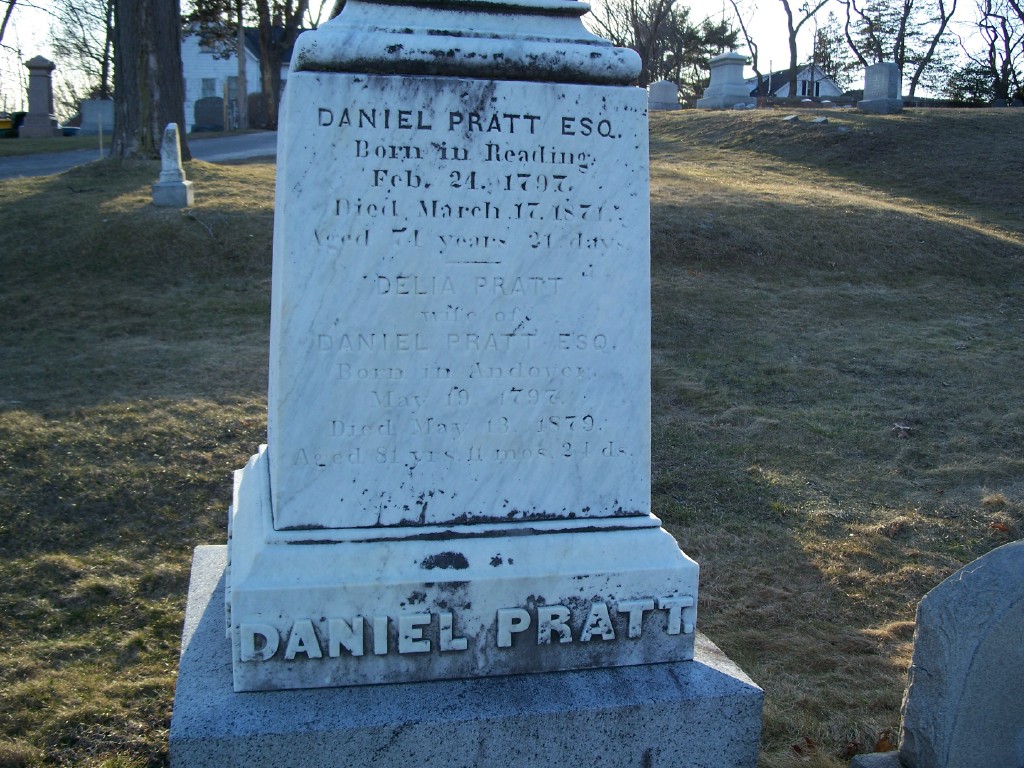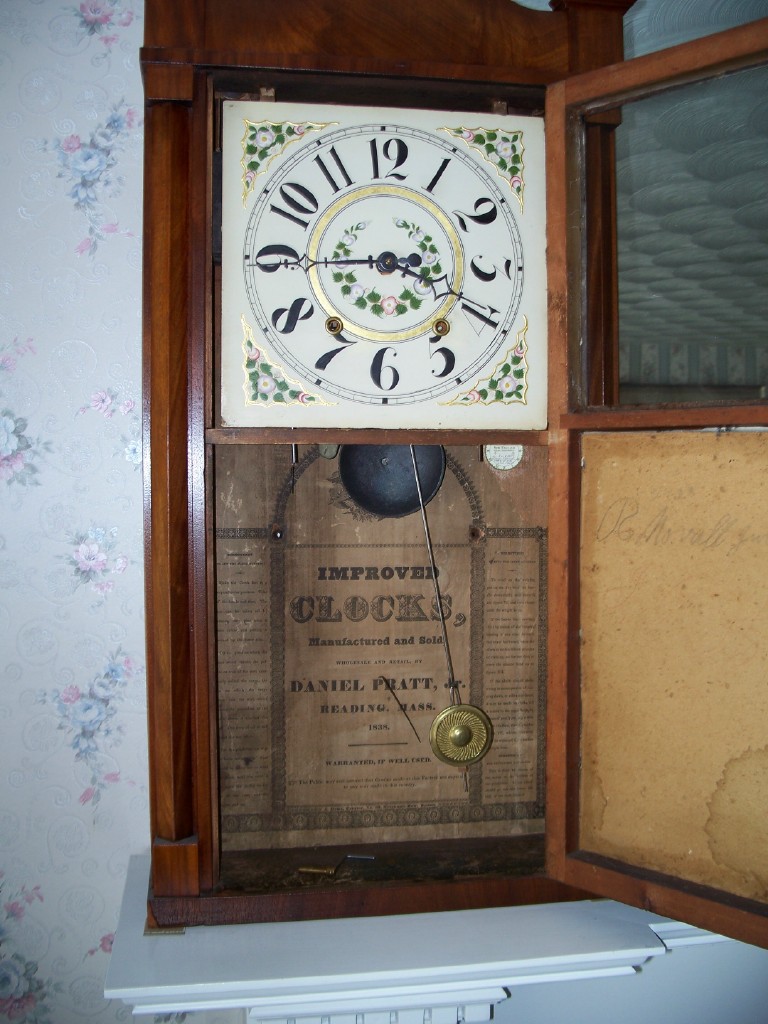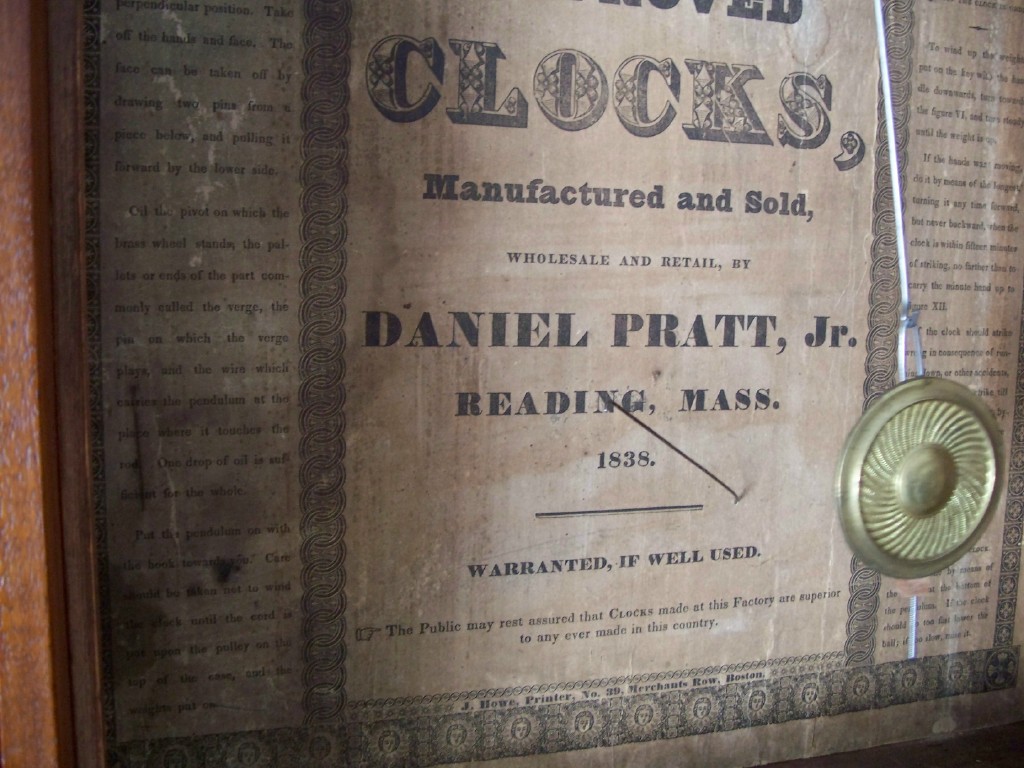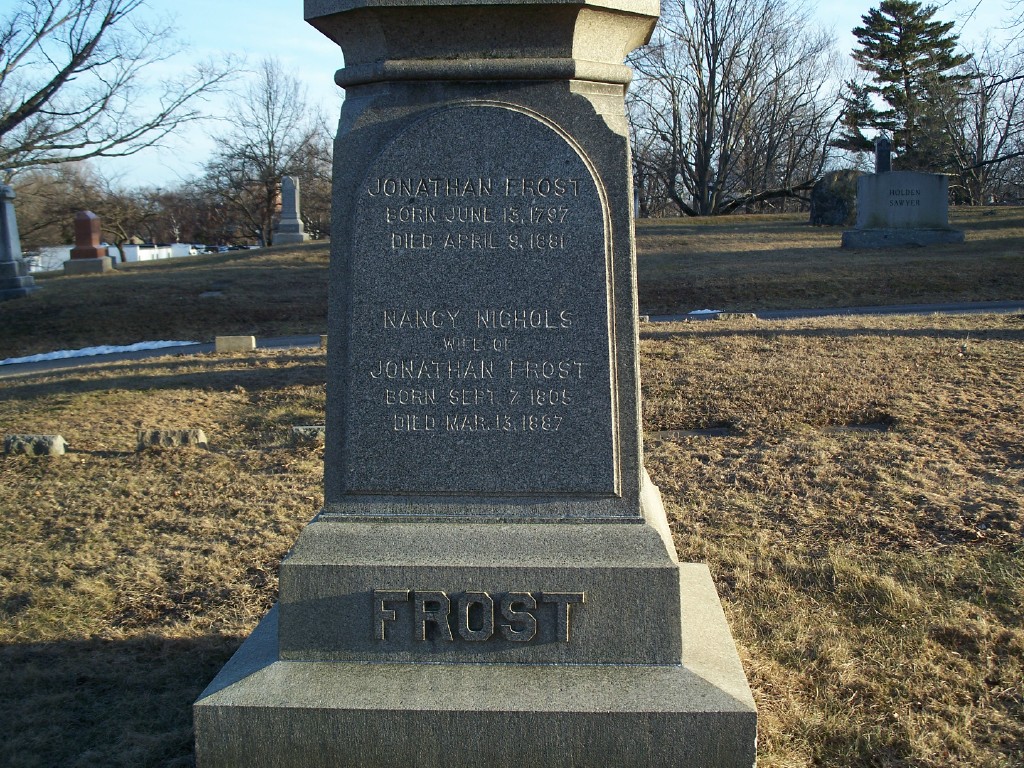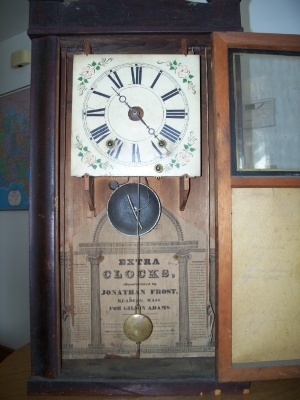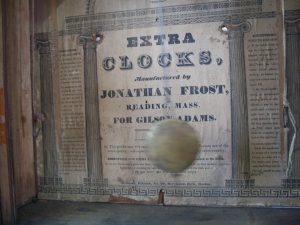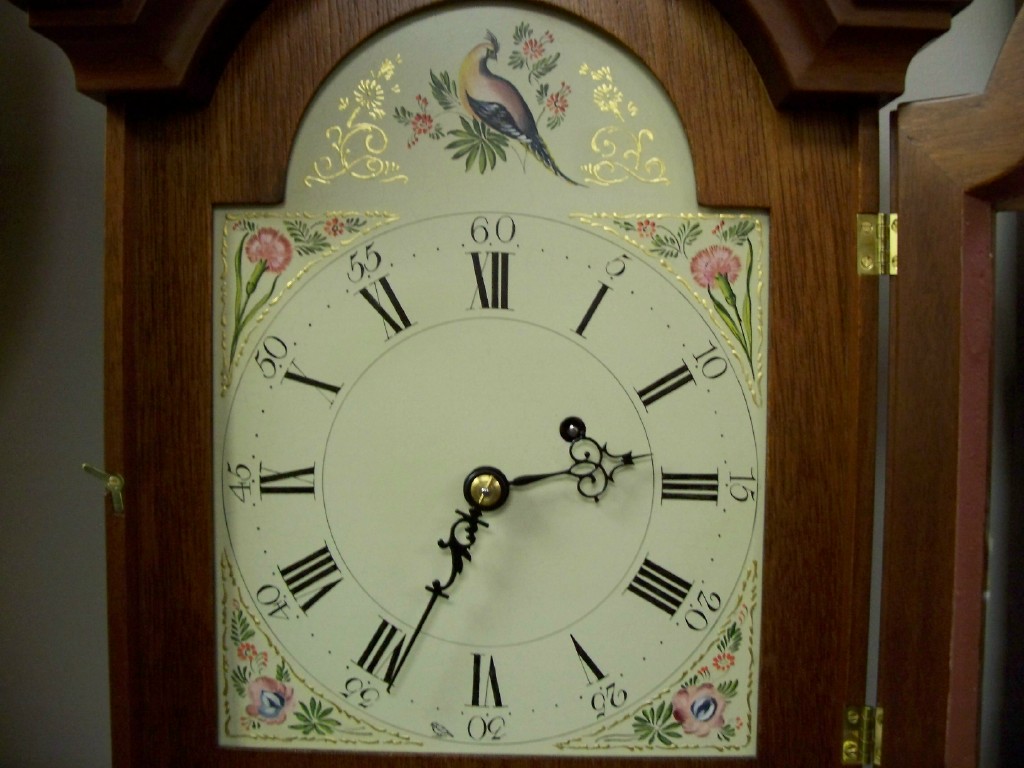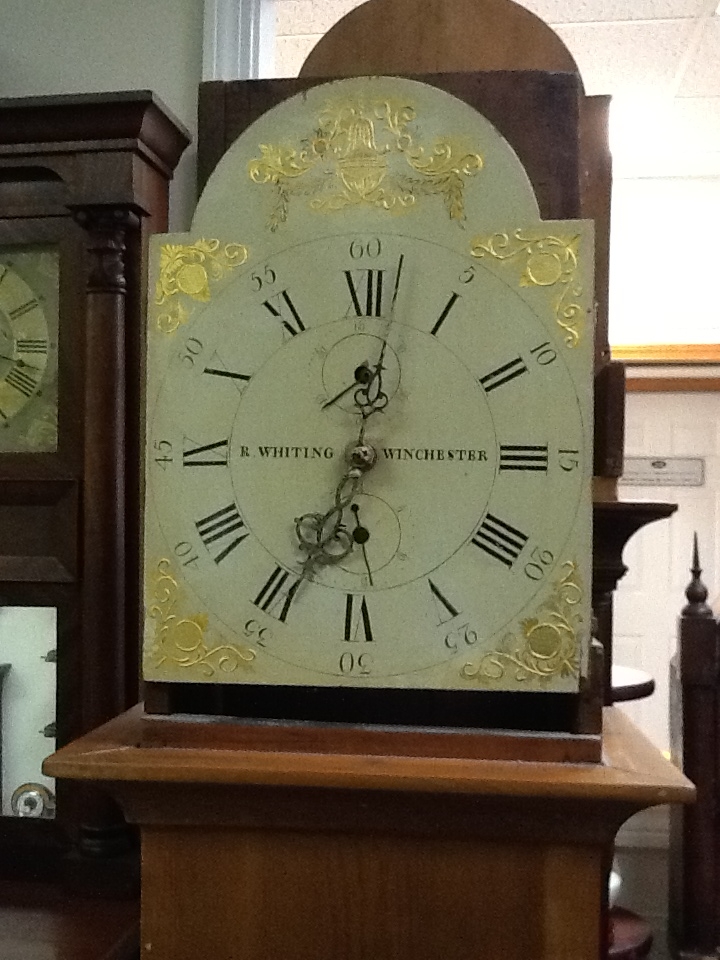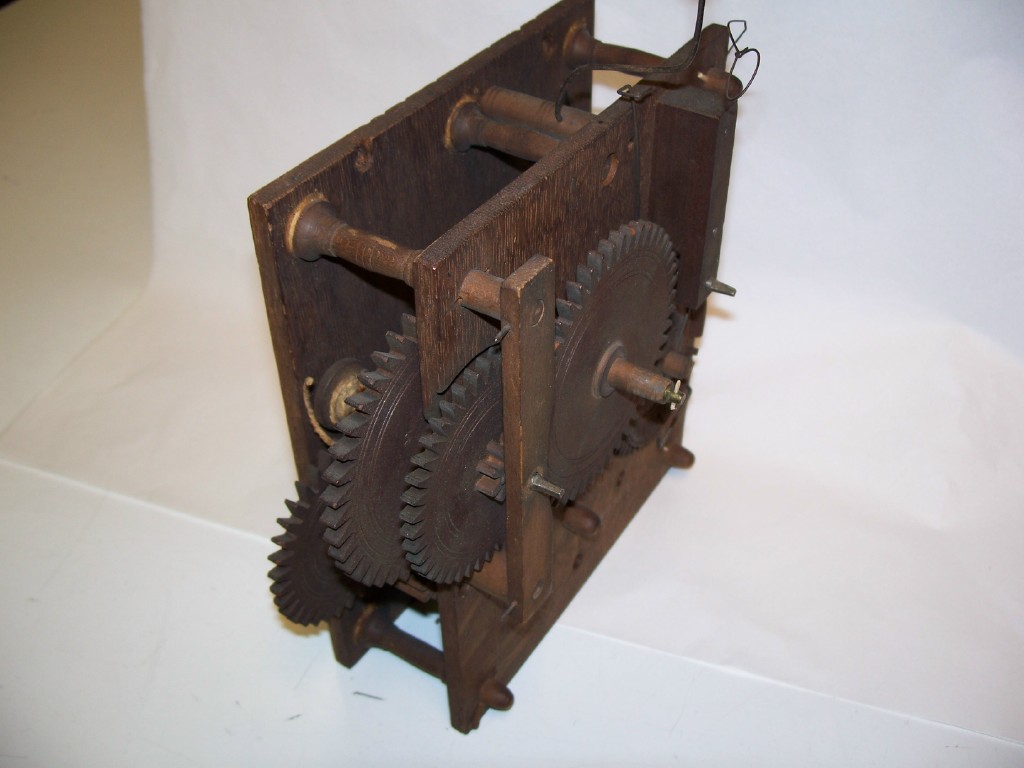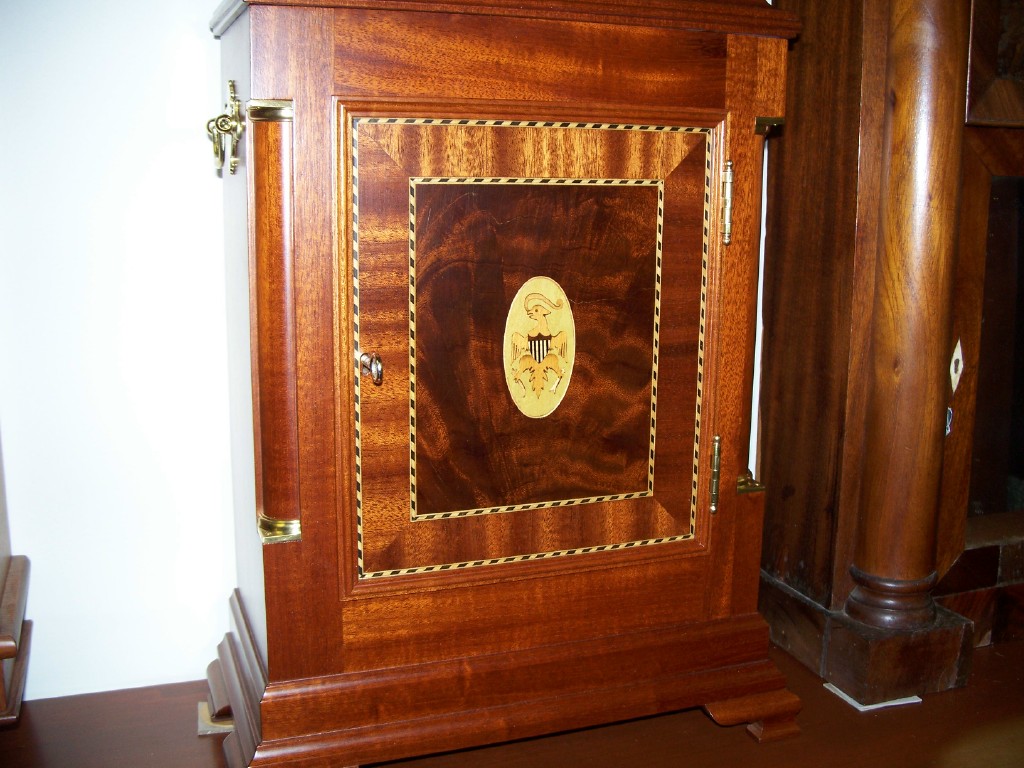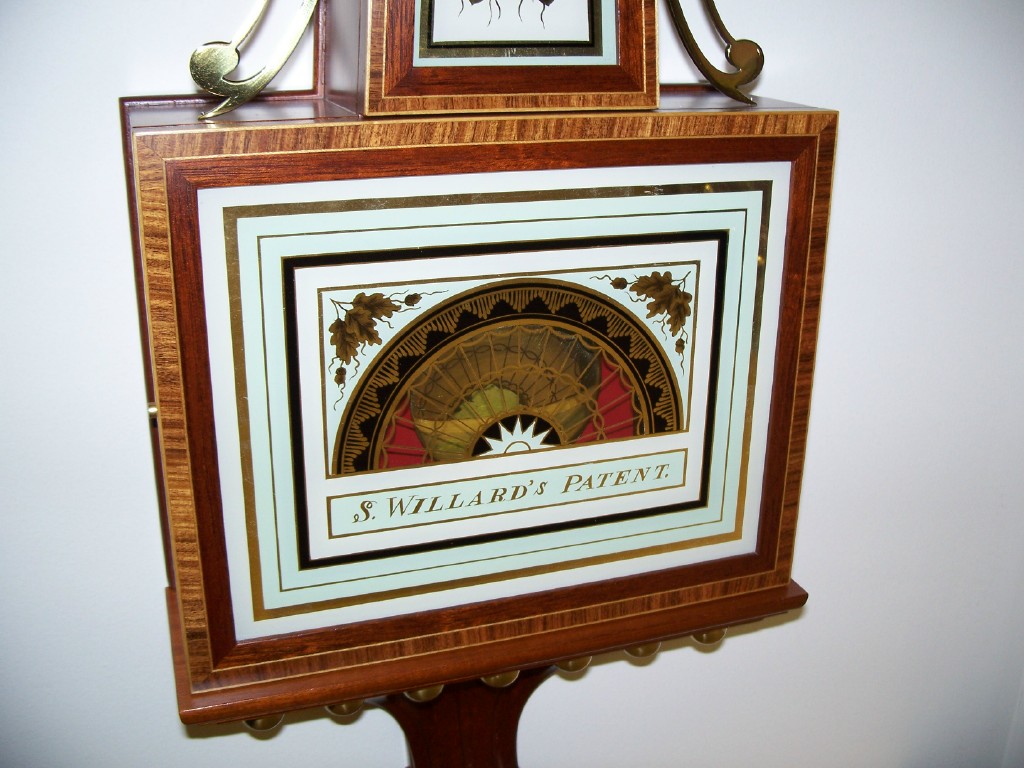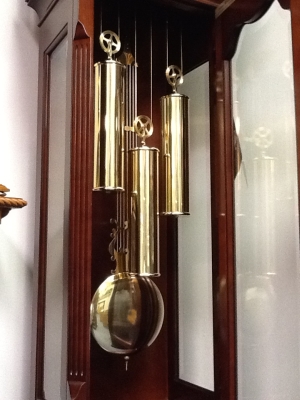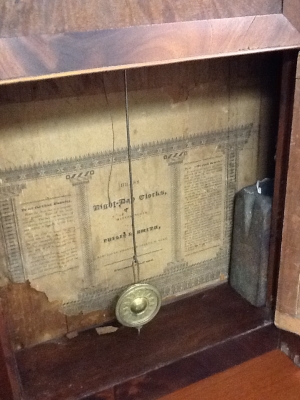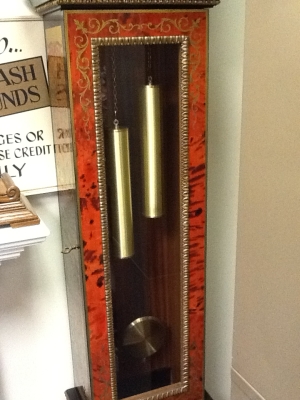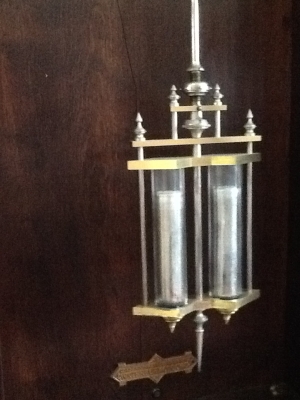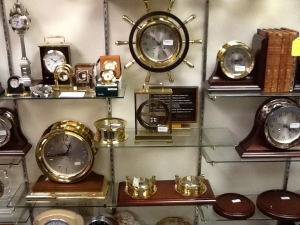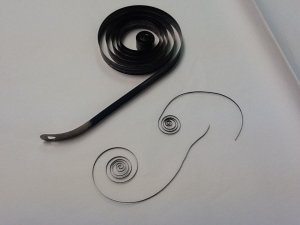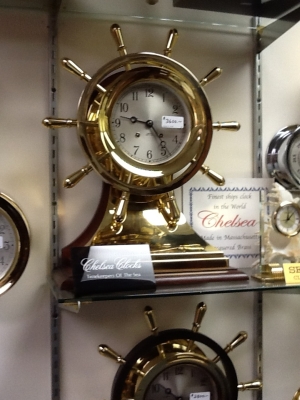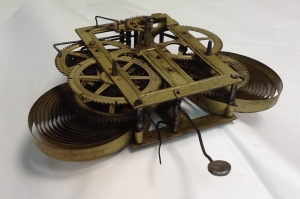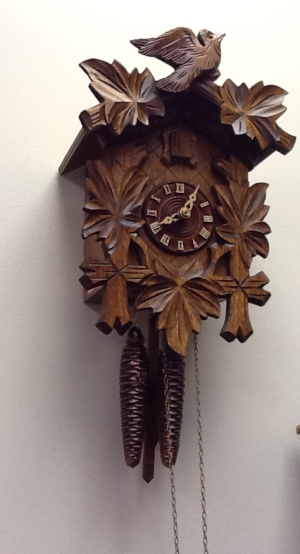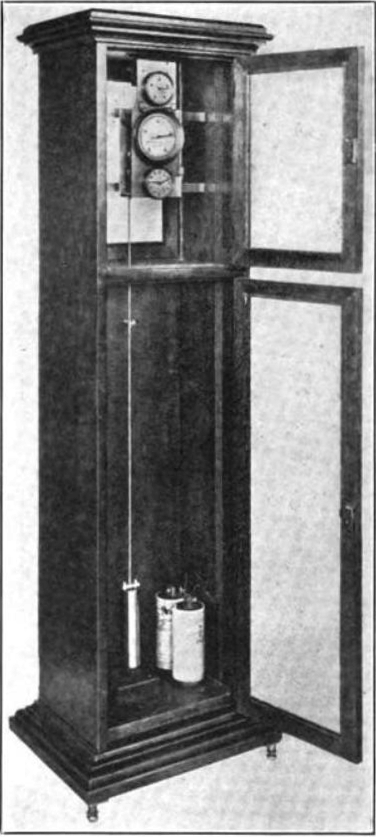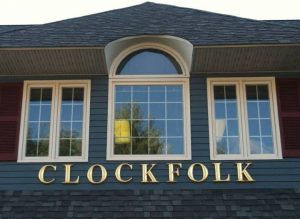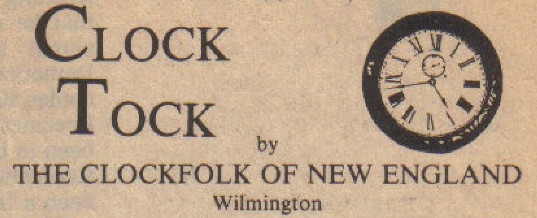
DECORATIONS ON EARLY AMERICAN CLOCKS were some of the most interesting and varied workings ever performed by early American craftsmen. For most of the 17th century, decorations were limited to carving or inlaid materials and were prevalent on only the most expensive, usually imported clocks. By 1800, fewer clocks were being imported and more were being made in America. In 1802, the banjo clock an American original design by Simon Willard made its appearance with complex artistic decorations such as reverse glass paintings (also known as eglomisé). These hand painted scenes were painstakingly painted on the back of a glass panel which was inset into a wooden frame making up the front of the clock. Gold leaf was often used and tediously worked to produce a three dimensional effect with artists oils subsequently being applied. A naval battle at sea from the War of 1812 was a frequent subject of the paintings.
By 1820, less expensive clocks were being produced which meant more people could now afford a clock. Stenciling with bronze powders became popular on clock cabinets and, on occasion, were even combined with the paints used in glass paintings. Some glasses had printed scenes while others were white frosted with etching.
Many clock faces used gold leaf to enhance their appearance and improve the clock’s sale-ability. The Clockfolk often restore, to match the original condition, clock faces or dials with gold leaf and hand painted floral decorations which belong to clocks with wooden gears made about 1820. Gold leaf was also sometimes applied to the cabinets themselves. Brass hardware, gold plated or plain, often decorated cabinets and some companies actually faked wood grains (called a faux finish) to give a more expensive look to the furniture.
AMERICAN CLOCKMAKING BEGINS
Nearly all of the very earliest clocks in America were imported. American competition grew slowly but strongly through the 1700’s when Pennsylvania clockmakers made more grandfather clocks than anywhere else in the United States. They too, however, relied heavily on British imports of raw and semi-finished materials sent here for clockmakers to buy, finish, assemble, decorate as they chose, and then distribute to American buyers.
By 1802, New England began to hold the lead in clock production with Massachusetts clockmakers making the banjo clock, among others, and Connecticut clockmakers were beginning to develop the wooden works in 1806. The wooden works put Connecticut in the foreground in production by the 1820’s, and by 1845, with the development of brass works, Connecticut clockmakers attained world supremacy in production. They were able to produce an inexpensive yet dependable clock unheard of before this time. This was a 30-hour weight driven clock invented by Chauncey Jerome (1793 – 1868) who by 1837 was selling the clocks for six dollars. This was the start of the downfall of the popularity of the grandfather clock in America.
Almost every state from Maine to Ohio to the Carolinas produced clocks—most in small qualities. It is said that Connecticut alone produced about one million clocks annually by the mid 1800s, most of which came from the Bristol area.
Many clocks which today are considered antiques were made locally right here in northeastern Massachusetts. There were clockmakers in Boston, Medford, Charlestown, Salem, Ipswich, Newburyport, Lexington and Concord, just to name a few. Commercial clocks, however, were made much closer to Wilmington. Col. John Osgood of Andover made grandfather clocks with brass works of good quality from 1790 to 1795, then moved to New Hampshire.
In Reading, there was a clockmaker by the name of Daniel Pratt, who worked from the 1830’s to the 1850’s. Occasionally one of his wooden geared clocks is brought into our shop for repairs; others are found in area homes and in antique shops miles away. Jonathan Frost also made wooden works clocks in Reading at the same time. One unusual feature of a Pratt or Frost clock is they they often had the date of manufacture printed on a label which was pasted to the inside of the cabinet. Often old labels continued to be used for the next year or so, with the original date on the label crossed out and the new year inscribed.
Pratt and Frost formed a partnership from 1832 to 1835, then each went on his own. Frost continued making clocks until about 1850, and Pratt until 1858. Their business was located in Reading Square. Grave sites of both men are at Reading Square in the Laurel Hill Cemetery behind the Methodist Church.
WINDING HOLES IN CLOCK FACES
Winding holes in clock faces are for different functions of the clock. If a clock does not strike a gong on the hour, it is technically called a timepiece. Timepieces have only one winding hole in the face because they do nothing but tell time. A clock that strikes on the hour has two winding holes—one for keeping time and one for striking. Each time another winding hole is present, another mainspring coil or weight must be wound to perform its particular function. A clock which plays a melody, such as Westminster chimes every 15 minutes, has a third winding hole for winding the chimes mechanism. This YouTube video shows a three-hole mantle clock at 12 o’clock, first playing Westminster Chimes, then gonging twelve times.
However, there is an interesting assortment of exceptions to the one-hole one-function rule. The Clockfolk recently serviced an old Seth Thomas clock with two winding holes, but no striking was possible. Both mainsprings drove the same gear, allowing the clock to run for 30 days rather than the usual one week between windings. We have also experienced an old grandfather clock which, after winding three holes, required winding a fourth mainspring to chime for a full week.
Then there’s the tandem wind. This has one winding hole, but winding both the time and the strike mainsprings is done by winding the key first one way and then the other, until both springs are fully wound.
THE BANJO CLOCK
The banjo clock is a wall clock with design and development credited to the United States. It has a round top to hold the mechanism, followed by a tapered narrow mid-section becoming increasingly wider as it extends downward. This houses the swinging pendulum and allows space for the driving weight to descend. A rectangular box is attached to the bottom of the tapered mid-section allowing room for the pendulum disk to swing. With a little imagination, one can see a cabinet similar to a banjo in shape. Regularly, ornamentation decorated the cabinet. A brass eagle or spire sat on top and long brass or wood side runners flanked the mid-section.
Simon Willard (1753-1848) of Roxbury, MA, patented the design in 1802, and its popularity soared. Originally the banjo clock was referred to as an “improved timepiece”. By the late 1800’s, nearly every clock factory was making banjo clocks in various qualities. Most banjo clocks made before 1900 were driven by a heavy weight, but by the 1920’s banjo clocks driven by coiled mainsprings became very common.
The fronts of the early clocks are often glass with hand painted scenes on the reverse, but most 20th Century models have paper pictures behind the glass. In the 1920’s, the Waltham Watch and Clock Co. of Waltham, MA, made quality reproductions of the banjo clock selling them for around $75.00. The Clockfolk has a number of new high grade banjo clocks made as if they were made 200 years ago. Today, production of banjo clocks is more limited than in the past, yet it endures as one of the most popular and sought after of all American clocks.
THE APPRENTICESHIP FOR CLOCKMAKERS
In early America, as in England, clockmaking by handcrafting involved many processes which needed to be thoroughly learned by an apprentice through years of devoted learning and service to a master tradesman. The youth usually began at about age 14, and was bound by written contract to a tradesman, usually for seven years.
The agreement formed between the master and the apprentice stated the master would teach the apprentice all the techniques of the trade, while the apprentice would help in finishing the work underway in the shop, be available always unless granted leave, and at all times discipline himself in proper behavior. Simple tasks were assigned at first, progressing to more complicated jobs as he became skilled in the art. The apprentice was not paid for his labor, but frequently had room and board supplied in the master craftsman’s home. A letter of recommendation was usually given at the end of the training, when the apprentice was now termed a journeyman.
This method proved beneficial to both. The master got free work from an interested future clockmaker thereby being able to increase his volume of work, while the apprentice learned accurately, dependably, and completely a craft to earn his living, and would carry on the craft for one more generation.
THE REGULATOR CLOCK
The word regulator, in reference to a clock, is indicative of a very precise, very high grade timepiece. Years ago, jewelers engaged in the repair of watches and clocks often had regulators for testing and judging their finished work. Railroads had regulators by which stationmasters assured the accuracy of train schedules. Observatories also had the need for precise regulator clocks to achieve exact time for celestial observations.
Usually regulators included a power source of a weight to insure consistently even power, a swinging pendulum which accounts for temperature changes, and acting surfaces made as friction-free as possible, often with jewels. No chiming or striking as used in order to avoid unnecessary vibrations to the mechanism. Basically everything was sacrificed for accuracy. To give best results, the regulator should be fixed to a wall as a free-standing clock will sway with the motion of the pendulum, thus affecting its time keeping.
The word regulator is much misused, being put on all sorts of clocks regardless of quality. The Waltham Clock Company and E. Howard & Co., of Boston were two of the best local makers of true regulators.
With electric clocks, and the advent of quartz timekeeping, dependable time can be achieved at less expense with less volume, leaving the regulator as an item of past craftsmanship and the attempt for perfection.
Click on photos to enlarge.
| (Below) Display of Banjo clocks at the Clockfolk’s shop in Wilmington. Each one has a unique reverse glass painting (eglomisé) on the bottom. | ||
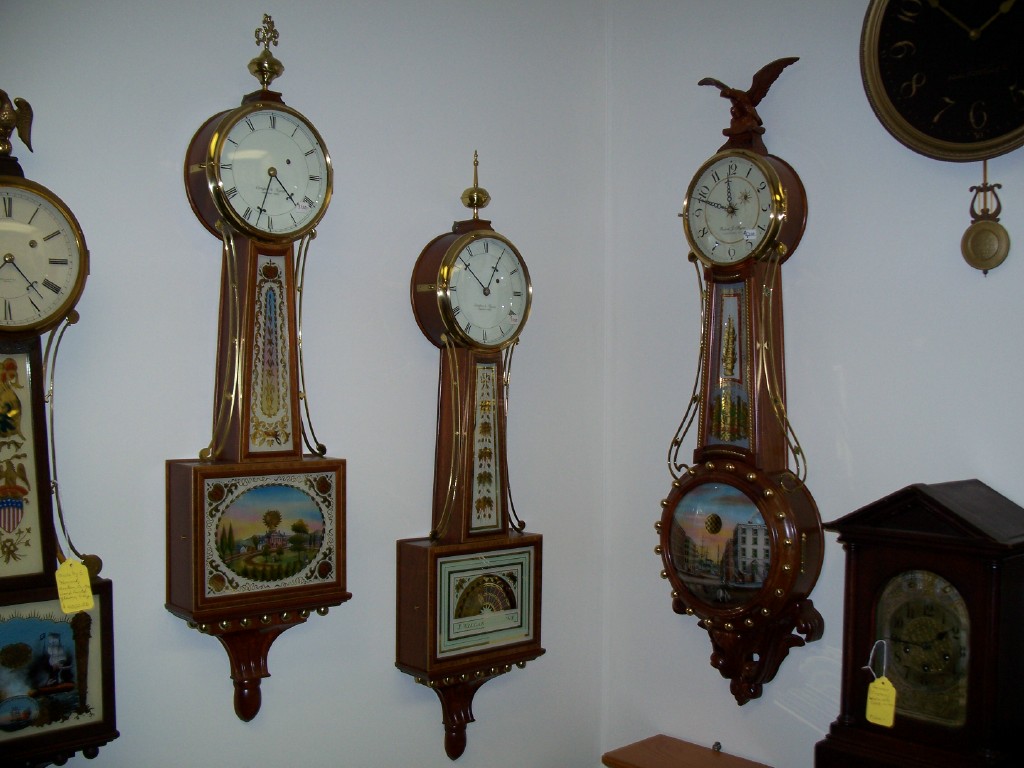 |
 |
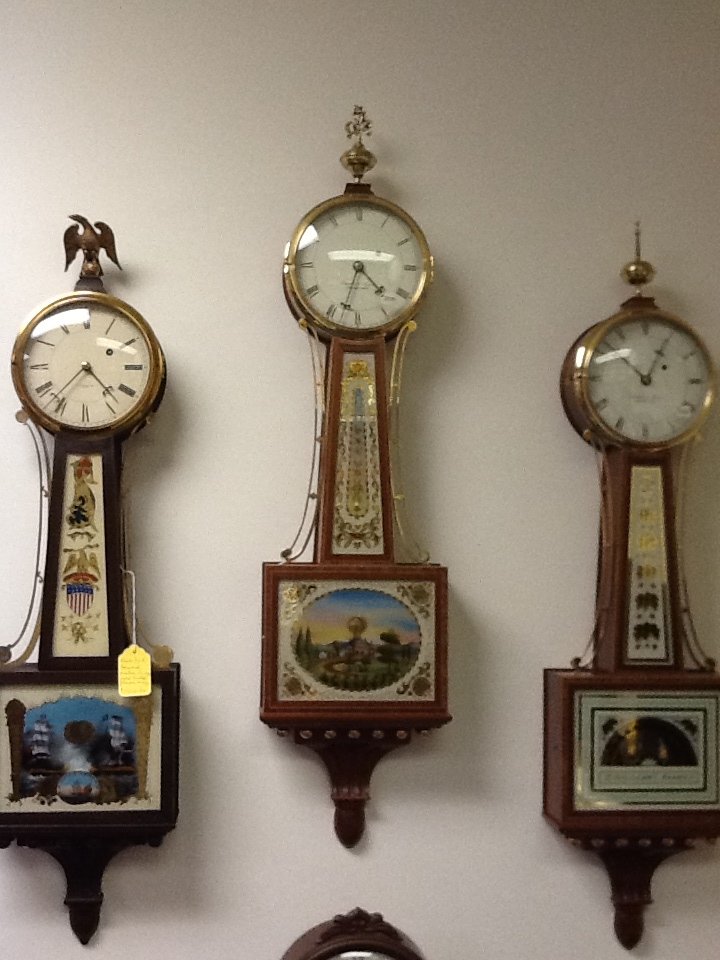 |
CLOCK WEIGHTS AS A POWER SOURCE
Weights run a clock by driving gears which, in turn, push a pendulum. Every mechanical clock before about 1450 ran from a weight hanging on a rope wound around the axle of the largest gear in the clock mechanism. Weights are still used to run many clocks today. It seems odd, with the advancement of civilization, that something as simple as a heavy iron weight would be used for the power source of such a necessary item as a clock. The reason is that weights give even power thus enabling excellent timekeeping to be achieved.
The weight is just as heavy when the clock is unwound as when it is fully wound. Mainsprings, on the other hand, get weaker as they run down, so the accuracy suffers. This is why most wind-up clocks are eight-day – so that if the clock is wound weekly, the timekeeping will have a chance to remain consistent (isochronism). Weights in clocks differ as to materials and poundage. Cuckoo clock weights are often half a pound, whereas Big Ben in London has three weights totaling two and one-half tons. Early weights were large stone blocks.
New England has many clocks in church steeples with weights made of field stones in wooden crates. We have heard of an old cannon serving continuous duty as a clock weight for a church in Cherryfield, Maine. Commercial clocks however, generally have a custom cast weight as deemed proper for the timepiece. Modern grandfather clocks have weights encased in polished brass tubes for appearance.
THE FUNCTION OF A PENDULUM
A clock’s pendulum regulates the timekeeping of that clock. The pendulum allows the clock’s power source to unwind, or “escape”, at a regulated speed. This is why some pendulums are short and others long. The gearing of any clock’s mechanism is matched to a certain pendulum length in order to keep proper time. A short pendulum will swing quickly and a long pendulum will swing slowly. However, both pendulums are of the proper length to keep correct time with the clocks for which they were designed.
In the mid 17th Century, of the several applications which were attempted fitting a pendulum to a clock mechanism, that by the Dutch scientist, Christiaan Huygens (16291695), was the most successful.
The basic pendulum, as we know it today, was invented in 1657 and proved that a pendulum clock could be a reliable source of time-telling. In an attempt to develop a more accurate device, revisions and improvements on the pendulum and how it drives the clock mechanism continued for nearly the next 300 years.
Developments compensating for the extremely slight lengthening or shortening of the pendulum in a warm or cold environment, were adapted to pendulums for higher accuracy.
About 1851 a different method of transferring the power from the clock mechanism to the pendulum was invented in Britain. It was invented by Edmund Becket Denison (Baron Grimthorpe, 1816 – 1905) and is called the double three-legged gravity escapement. In this invention, instead of the clock gears directly giving the pendulum a periodic gentle push to keep it in motion, the gears lifted little arms and allowed them to fall on the pendulum’s rod. This provided enough impulse to keep the pendulum swinging and rendered the pendulum more independent of the mechanism and henceforth unaffected by thickening oils or inevitable wear in the clock.
The pendulum clock reached its height of sophistication about the 1930’s, with incorporated developments from electrical impulses to non-expandable alloys.
HOW ARE PENDULUM CLOCKS AFFECTED BY TEMPERATURE CHANGES?
It is well known that materials expand when subjected to heat and contract when exposed to cold. This has a slight affect on all pendulum clocks. The pendulum is the timekeeper of a clock. A clock which has a pendulum consisting of steel rod will expand in length and become slower by about two and one-half seconds a day for each 10 degree rise in temperature. Of course the clock will run faster if the pendulum is subject to cold because its rod would contract, making the pendulum shorter. High grade clocks often are equipped with specially made pendulums to offset, or compensate for expansion and contraction.
Inventions to compensate such variations were developed in England as early as the 1720’s. One such invention used a jar of mercury swinging to and fro at the bottom of the pendulum. As the steel rod expanded downward—lengthening the pendulum, the mercury expanded upward in a reliable counter-action. In 1896, a metal alloy of nickel and iron, called invar which has a near-zero coefficient of thermal expansion, was invented by a Swiss physicist named Charles Édouard Guillaume (1861-1938). Its expansion at the different temperatures a clock is likely to encounter is negligible and thus it all but eliminates the effect of temperature changes on pendulums.
AMERICAN MADE CLOCKS
Few clocks are made completely in the U.S. today. Most of the internal mechanisms are imported from Germany, although lesser quality clocks are available from Korea, Japan, and China. Asian clocks are generally a copy of what America made years ago, but the metals are not as good and the engineering flaws become evident once servicing is required. They look just the same, but aren’t. They use longer mainsprings to provide a longer running duration, but that doesn’t make them good clocks. The Asian clocks usually say they require winding monthly rather than weekly, although most of them don’t run 30 days.
Today the purely all American-made clock is a rarity; most clocks on the market are partially or wholly imported.
The Chelsea Clock Company still makes some of the finest clocks in the world in a turn-of-the-century factory in Chelsea, Massachusetts. In operation since 1897, Chelsea manufactures each clock carefully, then inspects and tests it before it is released to distributors. Specializing in clocks which strike the ship’s bell, they also manufacture hour striking clocks of very high merit.
Scattered throughout the country, small individual makers perfect fine heirloom-quality clocks, many of which are on display for sale at The Clockfolk’s store in Wilmington. These clocks we offer are 100% American made with great quality movements and cases, containing no imported parts. With superb craftsmanship executed, these clocks are built to be handed down generation after generation to become your family’s true heirloom.
WHAT IS A MAINSPRING?
A mainspring is a flat coiled ribbon of spring steel used to supply the driving power to the gears of a clock. An average clock requiring weekly winding would have a mainspring about eight feet long. Often a little longer mainspring can help even-out timekeeping during the clock’s running duration. During the winding process, the mainspring is turned inward from the center creating a smaller coil with each turn until the coils are touching and the clock is fully wound. A clock mainspring cannot be wound too tightly as long as it has not been forced beyond a full wind. If the clock is in good order and the mainspring is lubricated well, then the mainspring will uncoil and the clock run whether fully or partially wound.
Credit for invention of the mainspring is often erroneously attributed to Peter Henlein (1485-1542) of Germany in about 1510. However, the oldest surviving clock powered by a mainspring is the Burgunderuhr (Burgundy Clock), an ornate, gilt chamber clock, currently at the Germanisches Nationalmuseum in Nurnberg, whose iconography suggests that it was made around 1430 for Philippe the Good, Duke of Burgundy.
The first mainsprings were made of steel without tempering or hardening processes. They didn’t run very long, and had to be wound twice a day. Henlein was noted for making watches that would run 40 hours between windings. A locksmith by trade, his invention made the portable timepiece possible and started the evolution destined to produce the pocket watch. In America, early clocks were driven by weights, but in 1836 springs began being made, the first of which were coiled brass. By 1850, steel mainsprings had replaced those of brass. Occasionally, antique clocks with brass mainsprings come into our shop for restorations. These brass mainsprings date a clock and show authenticity and we discourage replacement of these original springs.
BRASS USE IN CLOCKS
Brass is still a very common ingredient in modern clocks. It is an alloy of two elemental metals, copper and zinc, and it makes a bearing surface for the turning steel axles in the mechanical clock. Brass was first used in clocks around 1550, in Europe, and was reserved mostly for cabinets or faces, with the gears still being made of iron. By 1600, the use of brass was adopted in England where gears were begun to be made of brass with only the small mating gears, or pinions, the axles, and the levers still made of iron.
Clocks with wooden works became popular in America primarily because of their low production cost. The casting and hammering of brass for making gears kept brass geared clocks costly in comparison to wooden geared clocks until about 1837, when a process for rolling brass for clock plates was developed in Connecticut. Even though brass is a relatively soft and pliable metal, it can be hardened by rolling brass plates between steel rollers under heavy pressure, similar to an old washing machine clothes wringer. When the metal is thus hardened its particles are condensed and it becomes a longer lasting bearing surface.
Today most clock mechanisms are still made of brass unless it is a battery operated decorator clock with plastic parts. This is largely due to tradition and public acceptance.
MOON PHASES ON GRANDFATHER CLOCKS
When we see a grandfather clock face, many times we see a face of a moon in the top arch. This face is painted on a turning disk which slowly revolves as the clock runs. As the disk turns a moon appears. This rise (or waxing) and falling (or waning) of the moon indicates the phase of the moon—whether it is first quarter, full moon, last quarter, or new moon. New moon is no moon visible in the sky. This is generally indicated on the clock by either a landscape or a seascape scene. Numbers cresting the arch, range from 1 to 29½ . These are the approximate number of days between full moons.
The moon phase mechanism occasionally was included in clocks before the l5th Century, but became popular about 1750. Though traditional today, much superstition surrounded the use of the moon’s phases on early clocks, particularly in relation to farmers. It was believed that seeds would germinate quicker and be healthier when sown during the waxing of the moon. One needs only to consult an old almanac to discover hundreds of moon-related pieces of advice to the farmer and householder. Probably the most practical use of the moon phase indications was the aid to a traveler who had to depend on the light of the moon in days when street lighting was non-existent and lanterns had limited effect outdoors.
CUCKOO CLOCKS
The cuckoo clock is one of the most recognized clocks ever made. The origin of the cuckoo clock as we know it today developed in the Black Forest of Germany, not from Switzerland, as is often wrongly assumed. Today, nearly all cuckoo clocks come from Germany. The only part of the cuckoo clock that comes from Switzerland is the musical box attachment, if the clock has one.
Invention of the cuckoo clock is unknown, since it’s early history is murky. There is a recorded case of a clock in existence around the year 800 with a bird emerging to announce the hours. Cuckoo clocks, as we think of them today, originated in Europe about 100 years before clockmaking in the Black Forest became established in the late 17th Century. As early as 1629, and again in 1650, there are written descriptions of “modern” cuckoo clocks in existence. However, by 1730 the Black Forest region of Germany was developing the modern cuckoo clock.
The first cuckoo clocks had cabinets which resembled grandfather clock faces—a square shield with an arched top in which a small door was fitted for the bird to appear. By 1870, the cabinet had evolved into the distinctive “cottage” carving which is universal today. While most operate by the weight of metal “pine cones”, some older cuckoos were run by coiled mainsprings.
It is interesting to note that the true cuckoo bird is known for its unpleasant habit of laying its eggs in another bird’s nest. It does not nurture its own young. In fact, the cuckoo eggs hatch sooner than other eggs in the nest and the young cuckoo then ejects the unhatched residents, attaining full attention of its newly adopted mother.
MECHANISMS OF CUCKOO CLOCKS
The mechanisms of all cuckoo clocks have bellows, pipes, and moving figures. Nearly all have weights hanging on chains to drive the mechanism. One is for the pendulum and hands, while the other is for the striking, cuckooing, and the motion of the bird. A third weight would accommodate a musical attachment and automated dancers. Looking into the back of a cuckoo clock, one sees a maze of wires, rods, levers, and gears, each with a specific angle to provide its function. On the hour, a hammer strikes a gong and twin rods each lift a very thin leather-clad bellows allowing them to fall when fully raised, one at a time.
Invented about 1740, the principal is based on the church organ pipe. Each bellows gives a puff of air to a small wooden pipe producing the “cuc” and then the “koo”. Sound is determined by the depth of the pipe, with the ”cuc” pipe being shorter than the “koo”, pipe.
Each stroke of the hour consists of a strike on a gong and a “cuckoo.”
The bird is a little mechanical toy that tilts forward when its tail is raised by a wire projecting from the top of one of the bellows. Small internal wires open the beak to call. The bird is mounted on a swinging rod which springs back into the clock when finished. A small connected wire causes the trap door to follow and shut. At its first introduction, and perhaps well after, the cuckoo clock has been an intriguing machine indeed.
ELECTRIC CLOCKS
Electric clocks have been around longer than most people realize. The first patent for a clock driven by electricity was filed on October 10, 1840, by a Scotsman named Alexander Bain (1818 – 1903). Bain’s early principals utilized the swinging pendulum and kept it in motion by an electro-magnet energized by a battery. The force of the electro-magnet upon the pendulum disk provided a constant swing as long as the battery’s energy remained. Many experts for the next 80 years condemned electric clocks as too troublesome and too uncertain to ever come into wide spread use.
In 1918, Henry Ellis Warren (1872 – 1957) of Ashland, Massachusetts, invented his synchronous motor. It’s constant speed was due to the 60 cycles per second delivered in ordinary alternating current (AC) electricity. His motors were made popular under the name Telechron, and were installed in countless millions of electric clocks and other devices.
The same idea of using the extremely regular electric alternating current is still used today in most modern electric clocks. And many battery clocks with swinging pendulums made today utilize the same principle Alexander Bain invented over 170 years ago.
 |
|
.

